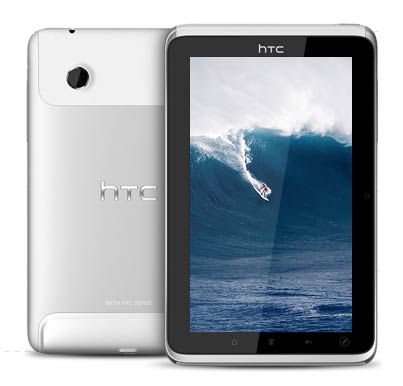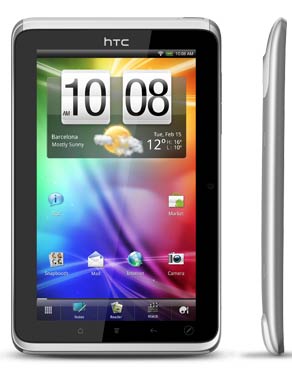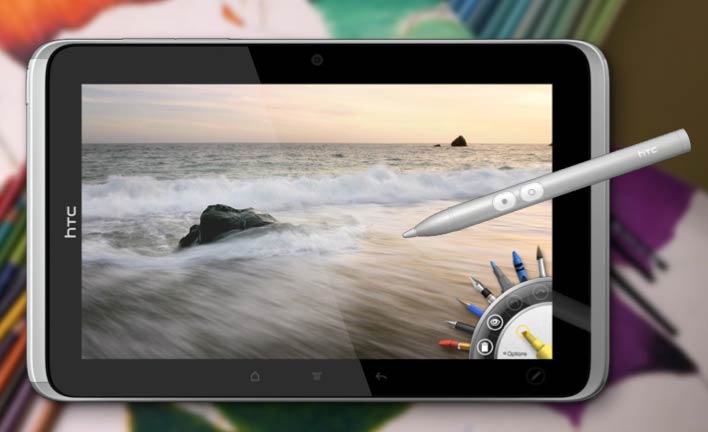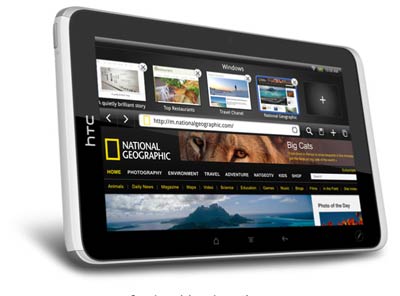HTC Flyer
HTC's initial tablet feels like a large phone,
but offers some interesting innovations
by Daniel Rasmus
During a convoluted set of speaking engagements and family travel, my HTC Flyer met me just across the Washington border as my wife Janet and I merged our itineraries near the Portland, Oregon International Airport for the final leg of a speaking tour that turned into the trip to retrieve my freshman daughter Alyssa from the University of Oregon.
 The first thing I liked about the Flyer was the size of the box. It was small, but I was soon to discover, that at least for me, small isn't always better when it comes to tablets. The second thing I liked, after unpacking the Flyer, was that it did not consider itself a companion to anything. The Flyer is a device unto itself, ready to perform out of the box. The first thing I liked about the Flyer was the size of the box. It was small, but I was soon to discover, that at least for me, small isn't always better when it comes to tablets. The second thing I liked, after unpacking the Flyer, was that it did not consider itself a companion to anything. The Flyer is a device unto itself, ready to perform out of the box.
I quickly connected to the hotel's WiFi and let the experience begin after a midnight arrival from San Francisco.
The Hardware
The HTC Flyer's 7-inch form factor is going to be a question of preference. Although it appears a more convenient size than the iPad of a Galaxy Tab 10.1, after using both of those devices, the Flyer felt, well, small. I wasn't sure how to hold it, and the implementation of virtual navigation buttons on the bezel made it even worse. I often find that I'm either holding the Flyer awkwardly to avoid tapping a button, or getting comfortable, and accidentally hitting a button. I've read some reviews where people give positive marks to the HTC curved frame, but it really didn't do anything for me, especially on a unit that weighs 14.8 ounces. Yes, the Flyer outweighs both the Galaxy Tab 10.1 and the iPad 2. The weight is pretty embarrassing considering 3-inch diagonal differential in display size.
Processor and Memory
With its 1.5Ghz Qualcomm Snapdragon processor, Adreno 205 graphics processor and 1GB of RAM, the HTC Flyer is indeed a pretty swift machine. From playing video to lobbing Angry Birds at various pigs and monkeys, the device performed admirably. Unlike most larger tablets, the Flyer retains a positive bit of its smartphone heritage, expandable memory. It would be hard to justify a more expensive iPad 2 if you could just slip in a $14 mini-SD full of videos. The Flyer thankfully allows for that, making units with more memory unnecessary. Unfortunately, the SD card fits under a removable plastic cover on the rear of the device that also holds the power button and the lens cover. With all of HTCs engineering experience, you would think they could make the SD slot more accessible, and eliminate exposing delicate components to its owners.
Display
 The 7-inch, 1024x600 TFT touch display is bright and clear. I had no issues viewing the display as I tilted and rotated the device. In bright shade, the screen does an OK job. In full sun, it fades to black (note, it is difficult to test a screen in full sun in Seattle, but at 4:32pm on June 17th I was able to perform a full sun test). I spent several hours on a two planes flying from the East Coast of the US to the West, and I watched several movies and podcasts -- let me just say the experience was much better than the small screen deployed several rows away.
The 7-inch, 1024x600 TFT touch display is bright and clear. I had no issues viewing the display as I tilted and rotated the device. In bright shade, the screen does an OK job. In full sun, it fades to black (note, it is difficult to test a screen in full sun in Seattle, but at 4:32pm on June 17th I was able to perform a full sun test). I spent several hours on a two planes flying from the East Coast of the US to the West, and I watched several movies and podcasts -- let me just say the experience was much better than the small screen deployed several rows away.
A 7-inch screen is never going to compare to a larger format, like the Apple iPad or the Samsung Galaxy Tab 10.1, but it worked. I do have to say, on a plane, in coach, with people leaning their seats back and with few places to stash my headphones, magazines and devices, the smaller device was easier to tuck into the available space. But unless you have an unlimited budget, I wouldn't recommend buying a Flyer just for convenience on an airplane.
Cameras
As with most devices, the 5MP read camera and the 1.3MP front-facing camera are for utilitarian work, not high quality production. The form-factor makes using the read camera less awkward than larger tablets. The front-facing camera isn't much use, as neither Skype nor Google Talk yet support video on this version of Android. I'm sure that's coming and the camera will prove adequate to the task. In the meantime its fine for self-portrait work. The camera app also supports video and easily switches between cameras.
Networking
The Flyer comes ready to connect via 802.11 b/g/n support and Bluetooth 3.0. Bluetooth include A2DP support for stereo headsets. I had no issue connecting it to various public and private networks.
The Pen is Mightier Than the Finger, Sort Of
The most distinguishing feature of the HTC Flyer is the optional HTC Scribe pen and Notes app. Within Notes, the pen work pretty well, but at about $80, this is a major add-on to an already overpriced tablet.
Pen experiences on the latest round of touch screen devices, any of them, is a subpar. For those of us who grew up drawing and ended up with graphite and charcoal all over our palms, drawing with detachment isn't natural. When in pure drawing mode the Flyer permits a close drawing interaction. The integration of the pen with the Flyer is a step in the right direction, though Wacom tablet and pen-based Tablet PC devices continue to offer superior pen performance. The biggest problem with the Flyer is that its pen's value drops off significantly outside of the Notes app, where screen shots and kids mode become the only way to effectively use the pen.

If you look closely at the screen, you will see fine features that represent the pen tracking technology. This may be a clue to the higher price of the Flyer, as it uses a very different screen technology. I like the feel of the pen on the surface, and the Notes application is one of the better apps I've seen for note taking, but as good as it is at emulating paint and pen, pencil and felt marker, it creates a discontinuity when navigating. If you want to use a menu outside of the pen area, you have to switch to a finger. The Reader apps, apparently a Kobo implementation, also supports the pen for highlighting. The highlighting is overly heavy, obscuring the text, and unlike the Amazon Kindle, the highlighting it only private, there is not access to community highlights or any shared markup.
In some ways, this discontinuity is good. When the pen is the center of the device's attention, you can lay your palm on the device and not worry about spurious input. On the other hand, you need to switch mental modes to go from drawing, to navigating and back. I often found myself trying to tap a menu that was waiting for my finger which reduces productivity.
Perhaps the coolest things about the Notes app is its tight integration with popular note platform Evernote. If you tie the Notes app to Evernote, it replaces that application and synchronized your jots and scribbles across all devices you own where Evernote is installed.
The worst thing about the Notes app is that it is stuck inside a small form factor device. This software cries out for more room to work. Although the precision of drawing on devices has improve dramatically over the years, nearly approach the fidelity of paper, the screen creates a barrier to more expansive thinking, scrolling only down and not across, so if forces people into linear thinking.
I am a big fan of pens because they permit much more precision, but they can also be lost and in this case, they cost extra -- and the Scribe pen doesn't even have a clip, so unless you buy the right case, you will always be worrying about what to do with the pen.
For some, the Scribe pen may be the tug that makes the Flyer a tablet of choice. I think it is a cool feature, one I would like to see in larger formatted tablets with even better software--and a list of partner apps that also support it. I would love to use the pen with iMindMap or other mind mapping software.
Other Hardware
The embedded stereo speakers product a tinny, but serviceable sound. The SRS WOW systems doesn't really wow unless the devices is connected to headphones or speakers, which generally make for a much more pleasurable listening experience. Watching a movie on the Flyer made me immediately want a stand built-into the device as various other stands I own were a bit wide for its small footprint. That of course, would cannibalize the inevitable accessory aftermarket.
Also under the hood on the Flyer are a G-sensor (for sensing movement), a GPS, a digital compass and an ambient light sensor. I'm not a big fan of ambient light sensors so I usually turn them off because I like a bright, even display brightness, regardless of its drag on battery life. And that first night, I had to eventually completely power down the unit as the GPS, very loudly, despite volume settings, kept notifying me, and the entire family, that it had lost its signal.
And speaking of battery life, the Flyer performed well in my cross-country test, allowing me to kill many pigs and monkeys, and free various exotic birds while also enjoying several hours of video. I didn't perform any formal battery tests, but like most tablets, the Flyer is an all-day device when used practically.
If you want to watch movies on a larger screen, another accessory converts the MHL port (combined USB/HDMI) into HDMI compatible output for your favorite computer or television monitor.
Software
The one nice thing about the iPad is you know what software to expect when you unbox it. Like Windows-based PCs before them, the Android tablets reflect the image of their engineering makers, not their core software supplier. And that means each Android tablet is a bit different, not only with the version of Android the device manufacturer selected, but with what pre-installed software is included. Even more, it means the experience itself is a competitive differentiator. The Flyer, for instance, can include animated weather on the lock screen, and it includes 4 icons that can launch immediately off the lock screen.
For a devices with a pretty small screen, HTC choose to go with action: animation, 3-D images and all kinds of widgets. Sometimes the Flyer feels a little executed (everything works) and under engineered (someone forgot that simplification is a design principle). 3-D transitions from screen elements to the clock, and plenty of movement in animated wallpapers. I've chosen to tone down the action, but much of it is just built-in.
And then there are general Android issues. The widgets for instance, take up space, a lot of space. Unlike the iPad, Android has no common organizing principle so widgets vary in size. Some things, like app icons, align well, but when it comes to widgets, the developers don't seem to have many guidelines for co-existence, leaving it to the end user to puzzle together their own experience.
With all the buzz around Instragram, it is cool to see HTC included a little bit of fun in the form of Snapbooth. Snapbooth let you take an image and apply a number of filters to it that distort, pixelate or otherwise get creative with an image.
For movie buffs, HTC has its own store (I know, just what we need, another media outlet in the cloud) called HTC Watch. It has the regular selection of current run movies and TV shows. If you have your own media, the gallery app provides access to both internal memory and the memory card, and performs the function of slide show and movie player, as well as integration with Facebook and Flickr.
The Flyer contains all the other basic Android gear from voice recorders to the market. All of which are slightly different depending on what versions you may be used to on phones or other devices. Again, getting to a consistent way or representing features and services will help make Android a higher quality experience.
Value
Sometimes smaller does cost more, but for tablets, I don't think that argument is value. The HTC Flyer is priced at the same entry level $499 as the Apple iPad and the Samsung Galaxy 10.1, both of which are superior devices, unless size is an issue or you want an integrated pen experience. At a starting price of $399, or $499 with the pen, I could see more value. The ability to stash a tablet in a jacket pocket may be worth it to some, but the value feels more like compromise than intriguing attraction.
Conclusion
The HTC Flyer, with its 2.3 Gingerbread build of Android feels more like an overgrown phone than a tablet, but it offers some innovations I would like to see taken elsewhere, most notably, then pen and the innovative lock-screen.  Both of those innovations should get other manufacturers thinking about how to make Android a better experience, and how hardware innovations can spread in the more open Android ecosystem. Both of those innovations should get other manufacturers thinking about how to make Android a better experience, and how hardware innovations can spread in the more open Android ecosystem.
The HTC Flyer is a functional, seemingly well-built device, with good battery life in a form factor that may appeal to those looking for a coat pocket tablet. For me though, the device's size made it awkward to hold, which was exacerbated by virtual controls in the bezel.
Unfortunately, for HTC, I was evaluating the Samsung Galaxy Tab 10.1 at the same time I was evaluating the Flyer, and the combination of form factor, weight and updated 3.1 Honeycomb operating system didn't help put the Flyer in a positive light.
HTC Flyer highlights:
- Small size makes it portable
- Pen differentiates the Flyer from other devices
- Snappy performance
- Various display and digitizer options with superbright QuadraClear sunlight-readable technology
- Memory Expansion via micro-SD
But keep in mind:
- Small size makes holding it awkward
- Pen use limited to a couple of applications
- Poor speakers
- Android 2.3.3, stable, but not designed for tablets
- Expensive, especially when counting $80 add-on pen
Daniel W. Rasmus is an independent analyst and strategy consultant. He is a former Vice President at the Giga Information Group and Forrester Research. Dan is the author of five books, including Management by Design (Wiley, 2010) and Listening to the Future (Wiley 2008). He blogs regularly at http://danielwrasmus.wordpress.com. Additional information can be found at http://danielwrasmus.com.
HTC Flyer Specs:
| Added/changed |
Added 7/2011
|
| Type |
Media tablet
|
| Processor |
Qualcomm Snapdragon, 1.5GHz |
| Chipset |
Qualcomm |
| Graphics |
Adreno 205 graphics processor |
| OS |
Android 2.3.3 |
| Memory |
1GB |
| Expansion slots |
1 microSD |
| Display |
7.0" 1024 x 768 pixel wide-format LCD |
| Digitizer/Pens |
Capacitive multi-touch |
| Keyboard |
onscreen |
| Storage |
32GB |
| Housing |
NA |
| Temperature |
NA |
| Drop |
NA |
| Humidity |
NA |
| Altitude |
NA |
| Enclosure Class |
NA |
| Safety |
NA |
| Sensors |
G-sensor, GPS/aGPS, digital compass, ambient light sensor |
| Size |
7.7" x 4.8" x 0.52" |
| Weight |
0.91 pounds incl. battery |
| Power |
4,000mAH Li-Ion ("4 hours") |
| Communication |
802.11b/g/n WiFi, Bluetooth 3.0, 3G (Quad-band GSM/GPRS/EDGE: 850/900/1800/1900 MHz), GPS/AGPS |
| Cameras |
Rear (5MP) and Front (1.3MP) cameras to support video chat through the video chat applications available in the Android Market |
| Interface |
microUSB, audio |
| Audio |
SRS WOW HD(TM) surround sound delivers impressive audio over the dual speakers or through headphones |
| Warranty |
1-year standard |
| Price |
starting at US$499 |
| Web page |
www.htc.com |
|













 The first thing I liked about the Flyer was the size of the box. It was small, but I was soon to discover, that at least for me, small isn't always better when it comes to tablets. The second thing I liked, after unpacking the Flyer, was that it did not consider itself a companion to anything. The Flyer is a device unto itself, ready to perform out of the box.
The first thing I liked about the Flyer was the size of the box. It was small, but I was soon to discover, that at least for me, small isn't always better when it comes to tablets. The second thing I liked, after unpacking the Flyer, was that it did not consider itself a companion to anything. The Flyer is a device unto itself, ready to perform out of the box.
 The 7-inch, 1024x600 TFT touch display is bright and clear. I had no issues viewing the display as I tilted and rotated the device. In bright shade, the screen does an OK job. In full sun, it fades to black (note, it is difficult to test a screen in full sun in Seattle, but at 4:32pm on June 17th I was able to perform a full sun test). I spent several hours on a two planes flying from the East Coast of the US to the West, and I watched several movies and podcasts -- let me just say the experience was much better than the small screen deployed several rows away.
The 7-inch, 1024x600 TFT touch display is bright and clear. I had no issues viewing the display as I tilted and rotated the device. In bright shade, the screen does an OK job. In full sun, it fades to black (note, it is difficult to test a screen in full sun in Seattle, but at 4:32pm on June 17th I was able to perform a full sun test). I spent several hours on a two planes flying from the East Coast of the US to the West, and I watched several movies and podcasts -- let me just say the experience was much better than the small screen deployed several rows away.

 Both of those innovations should get other manufacturers thinking about how to make Android a better experience, and how hardware innovations can spread in the more open Android ecosystem.
Both of those innovations should get other manufacturers thinking about how to make Android a better experience, and how hardware innovations can spread in the more open Android ecosystem.